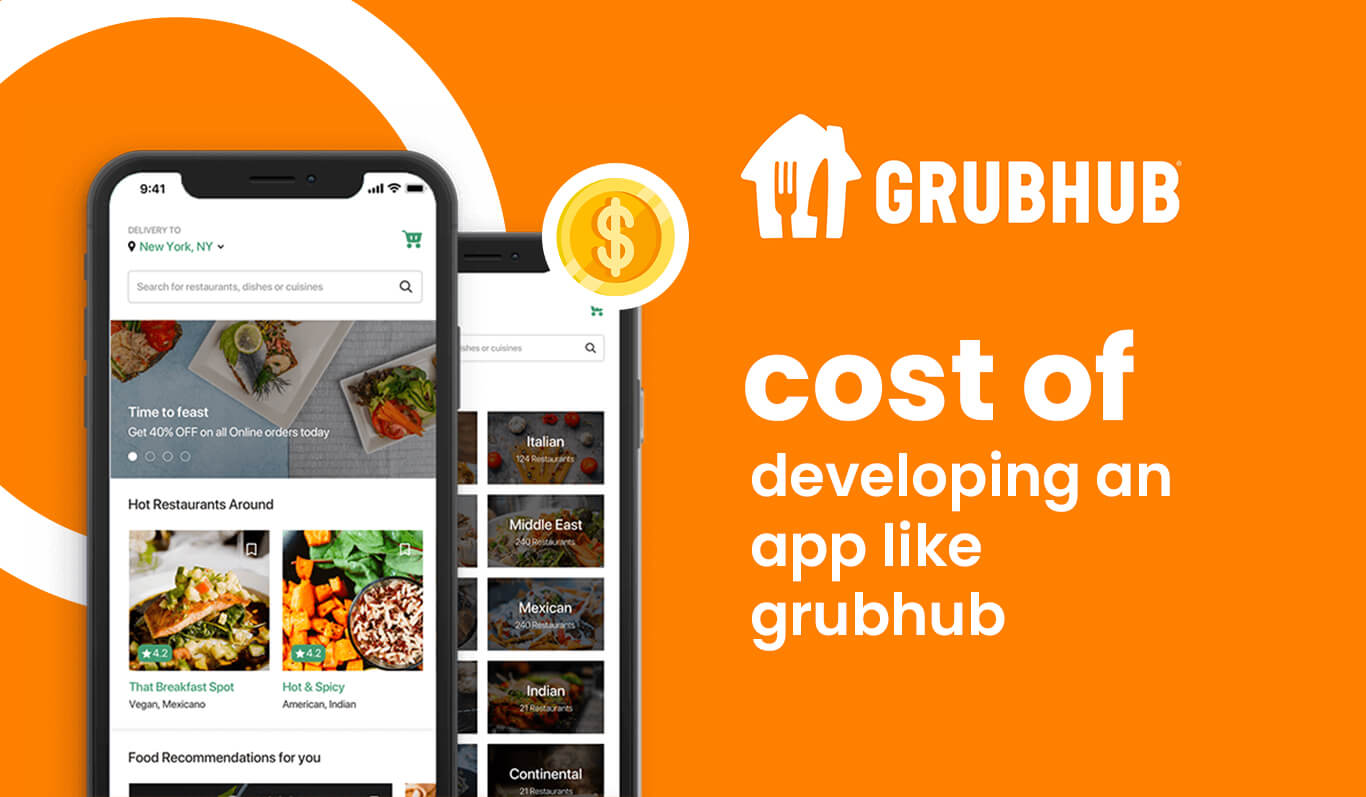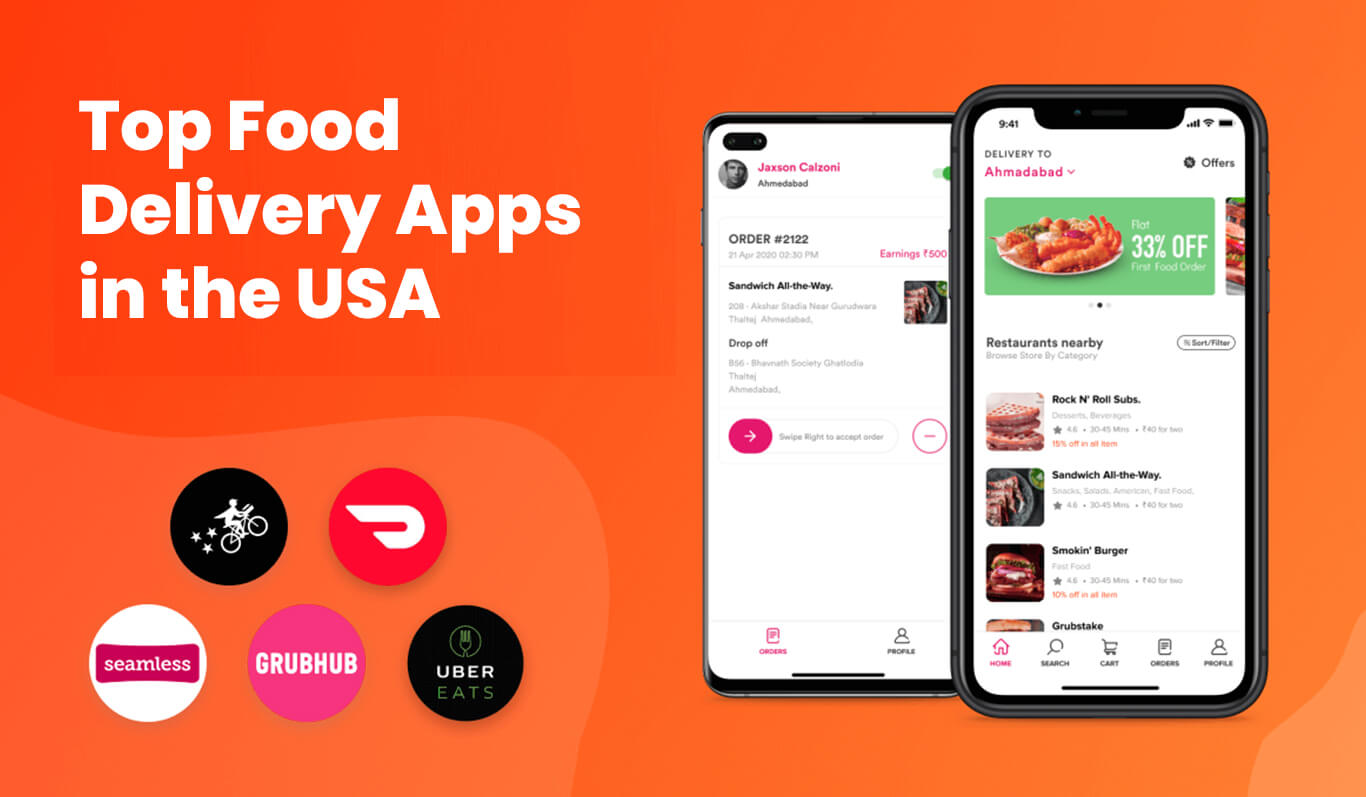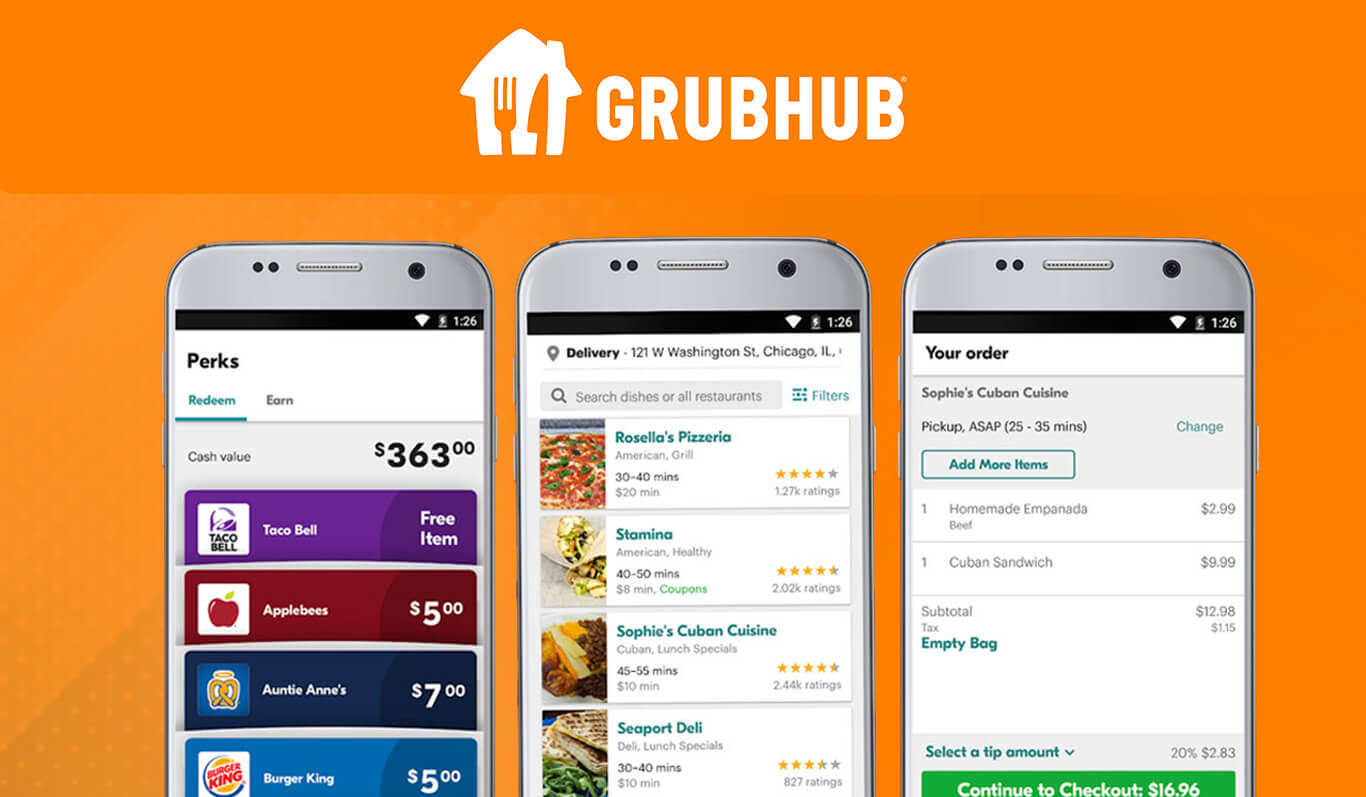How Much Does It Cost to Develop an App Like Grubhub in 2022?

During the global lockdown, several restaurants went online due to Covid restrictions. Even after the restrictions were lifted, most customers seem to still prefer the convenience of online ordering. Apps like GrubHub and Postmates are preferred by customers who enjoy the comfort of dining at their homes compared to dining out.
Before building an app like Grubhub, let’s also look at the following questions. Popular food delivery apps in the USA How to make an app like Grubhub? How to grow your revenue with a food delivery app? What are the essential features of an app like Grubhub?
Top Food Delivery Apps in the USA

1. Uber Eats
Uber Eats is one of the USA's most popular online food ordering apps. Users can request food delivery right to their doorsteps from local food outlets and restaurants. There are over 6,000 Uber Eats locations in 45 countries today. This company has taken many measures to protect its customers and drivers. With approximately more than 100 million users on the Playstore and 50 million+ users on iOS, UberEats' user base grew to 50 million+ users in 2020.
2. Postmates
In more than 100 major metro areas in the US, Postmates offers on-demand goods delivery services enabling people to get anything from local stores delivered right to their doorstep. Like Uber, Postmates offers a similar service, but instead of taxis, Postmates allows a customer to purchase goods locally. Using human couriers, Postmates delivers goods within the city, so anyone can order anything from anywhere. The Postmates couriers receive order notifications via their mobile devices, just like Uber drivers. Using GPS, the company ensures that demand and supply are met as quickly as possible.
In addition to attracting substantial funding from investors, Postmates' distinctive business model has helped the company acquire a significant following of customers. In just four years, Postmates has gone from strength to strength.
3. DoorDash
DoorDash connects restaurants and food delivery via on-demand food delivery services. Their service delivers food to homes and businesses through partnerships with local restaurants. Delivery from DoorDash is available in hundreds of cities across the country. It works with restaurants, allowing them to set menu prices while maintaining control over delivery and service fees. With DoorDash's fleet of freelance delivery workers called Dashers, restaurants do not need to hire their delivery workers. Dashers get paid via tips, a salary from DoorDash, and by completing challenges. This makes starting a restaurant food delivery business easier for restaurants.
Revenue Channels That Drive Grubhub
The strategically planned revenue model is one of Grubhub's success factors. It is what led to the massive valuation of Grubhub in the marketplace, outpacing its competitors. The main sources of revenue for Grubhub are:
Delivery fee
Grubhub charges a delivery fee for successful order delivery. During the offer season or by applying discounts, the delivery fee can get reduced. The fee is split into an 80:20 ratio, with 80% of the delivery fee being paid to the courier service and 20% of the amount going to Grubhub. Like other delivery apps, delivery fee increases during peak hours and unfavorable weather conditions. Distance is also a factor that influences the price of the delivery service.
Convenience fee
Grubhub charges an additional convenience fee for each order placed on top of the delivery fee. Users are more than happy to pay the convenience fee to get the orders conveniently delivered to their doors. But unlike the delivery charge, the convenience fee goes directly to the company.
Ads and marketing
Apart from commissions, GrubHub also charges restaurants for marketing and advertising on its app. A restaurant's name can appear for a limited time on the list of the top restaurants.
How to Develop an App Like Grubhub?
Perform thorough market research
As soon as you've established the focus, determine whether similar applications exist in the area. Participate in local communities, browse the Play Store, and contact local businesses. Be sure to ask the following questions:
- Is there a need for an app like Grubhub?
- What other similar apps are on the market?
- If yes, how is the reception to such apps?
- If not, do you think your app will be accepted by local businesses?
- What unique service can you provide for them?
If your competitors hold a significant share of the market, you must analyze and understand their apps. Assess its UI/UX, its strengths and weaknesses, and the opinions of its users. Develop better UI/UX and offer more appealing and useful features on your app. You can win a war if you know your opponent.
Choose a Business Model
The business model you select for your food ordering app depends on your business requirements and goals. The following are various business models that you can adopt for your food delivery app.
- Order-only model
Through the order-only model, consumers connect with local restaurants and order food using the application, which helps boost food orders for the restaurant. Restaurants are entitled to pay fees to the owner of the application each time they receive an order via the app. Fees can include both setup fees and commissions on orders received.
There is a flat percentage fee on all orders, no matter how big or small they are. Setup fees are charged in addition to commission fees. This model puts the responsibility for food quality, service efficiency, and more under the control of the food provider, not the app owner. The focus of restaurant discovery apps is primarily on placing orders.
- Order and delivery model
In this model, the service includes food delivery as well. The application owner is responsible for managing order delivery through the application. On every order purchased via the app, restaurants receive commission and delivery fees. This model offers a number of advantages to app owners, including control over courier management and delivery times. Through this model, restaurants can improve their users' experience and improve loyalty.
- Fully integrated model
App owners have complete control over everything inside their mobile apps, such as how food is prepared and delivered. It is expensive to build a fully integrated app, but the owner is in control of all the aspects of the service, from the quality of the food to the speed of delivery. Therefore, there is an increase in revenue as a result of a higher customer satisfaction rate. The whole point of meal apps is to make food accessible and to deliver it to customers. In the past, customers ordered food for delivery by phone. This has now been replaced by food delivery apps.
Create a Prototype
Make a prototype after you've explored your potential customers' needs and preferences. As the first step in this direction, discuss your app idea with a business analyst. By identifying the user's pain points and addressing them through your app, this person can help your application to be a success. Further, a business analyst may be able to help you clarify your vision of the perfect design of an app based on their experience with similar applications. Once the feasibility of the app has been assured, you can proceed with the designing of the first look of the application. Discuss your requirements with a UI/UX designer who can turn your concept into an interactive mock-up on the laptop screen. They design each screen's interface, build the mock-up, and show how each screen is connected to the other. You will be able to picture your final app based on the mock-up.
Proceed with MVP development
It is easier to start working on the MVP once you have a ready-made app prototype. Depending on your needs, you can choose between native, web, or hybrid development. Consider hybrid software development, as it is a cost-effective and at the same time efficient approach. Among your engineering team members are business analysts, designers, front-end and back-end developers, quality assurance engineers, and project managers. Once your app is profitable, you can expand the tech squad to 10 or even more professionals.
Features Selection
Developing a food delivery app means integrating these essential features as well.
- Registration and Login
- Order placement
- Payment integration
- Track an order
- Reviews and Ratings
- Discount coupons
But some features help to simplify the task of placing an order providing more convenience to a user. For e.g., the search and filter option allow users to search for a specific restaurant, dish, or cuisine, or even find restaurants within a specified distance or price range. Let us have a look at the different features that can be included in a restaurant delivery app.
Customer app features
Registration/Login
Register and log in to the app using social credentials or number/mail id.
Save card details
Users can save payment details for faster checkout.
Save delivery address
Users can either select the delivery location on the map or enter the address manually.
Order history
View previous orders to repeat orders or help you make a decision faster.
Ratings and feedbacks
Rate or leave feedback based on your experience.
Delivery partner app features
Registration
The delivery executive can register his details including name, vehicle details, etc.
Booking an order
The courier partner accepts/rejects the order based on availability.
Delivery status
The delivery status for the order can be set as accepted/rejected, picked up, and delivered.
Booking history
The courier service provider can browse order booking history.
Restaurant app features
Admin Panel
Keep track of orders placed, deliveries, and inventory through the admin panel.
Order Placement
Manage orders placed.
Notifications
When an order is placed, drivers will receive a notification. Customers will receive a notification when an order has been accepted.
Payment Menu
Provide invoice to the customer through text and/or email.
Ratings
Review the feedback received to improve the service provided.
Cost of Developing an App Like Grubhub

On the basis of various aspects such as:
- the features you are looking to include in your on-demand food delivery app,
- the resources you would need to transform your app from its idea stage to the launch stage, and
- the development company you approach to get your app developed,
the development cost of an app like UberEats or GrubHub will likely be between $30,000 to $40,000/ In general, the food delivery mobile app development company's costs will include various service costs such as design, development, testing, and deployment. Depending on your requirements, you can choose the services needed.
Conclusion
The importance of online platforms for businesses in the present day cannot be overstated. By conforming the structure of a business to the market, a business will be able to learn from the best and create an app like Grubhub.
The key to making informed decisions is to understand the business and technological aspects. For this reason, Neetable, a food delivery app development company in the USA and India, is the right choice to create an app like Grubhub and Postmates. Through our years of experience, we can help you create an app for your company. This app will be able to build a broader and more loyal client base and help scale your business.
FAQs
1.What is the cost of developing an app like Postmates or Grubhub?
Building an app like Postmates or Grubhub can be quite complex depending on additional features that you want to be integrated into the app, the time taken for development, etc. The cost can vary from $30,000 to $40,000 approximately and can go higher depending on the number of platforms and other factors.
2.How to develop an app like Grubhub?
- Understand the target audience
- Perform market research
- Find an app development company
- Build an MVP
Request a Quote
Categories
Popular posts
Best Practices for Software Product Engineering Every CTO Should Implement
2023-14-18How to Build Your Own On-Demand Carpooling App Services?
2023-08-25How to Start an On-Demand Fuel Delivery Business: A Comprehensive Guide
2023-07-28Empowering Miners: How Fleet Management Apps are Transforming the Mining Industry?
2023-07-21A Complete Guide to Develop a Food Delivery App for Restaurants in 2023
2023-07-08Mobile Apps Transforming the Travel Industry: A Game-Changer in Travel Planning and Experience
2023-07-07
